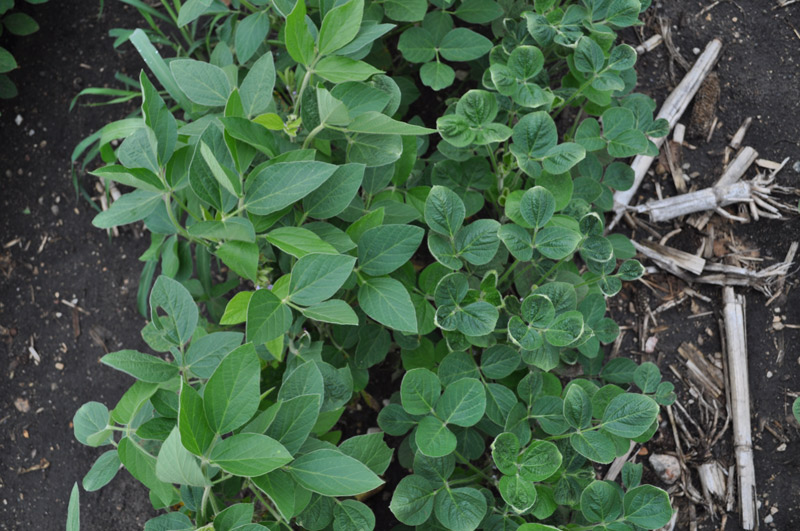August 7, 2017

As the number of off-target dicamba injury complaints continue to roll in, one question that we often get asked is “how will this injury affect my yield”. A few weeks ago we posted a manuscript from one of our former graduate students Andy Robinson that directly addressed this question. The purpose of this article is summarize this into a more user friendly format to share our experiences with plant injury response and measurable yield components when non-Xtend soybean are exposed to low levels of dicamba.
There are a number of research papers published on this topic dating back to the 1960’s. Most of this early work showed that it was difficult to find a reliable early-season measurement that predicted yield loss. A few of the authors found that height reduction was a somewhat reliable indicator of yield loss, but the amount of yield loss varied quite a bit from experiment to experiment. We initiated this research in 2009 in anticipation of the issues that cropped up this year and wanted to be able to provide some insight into yield response of newer soybean varieties.
In this study we applied 8 different rates of dicamba, ranging from 1/10,000X to 1/25X of the 0.5 lb per acre labeled use rate (12.8 oz/A of Engenia or 22 oz/A of Xtendimax/Fexapan). These treatments were applied either at the V2, V5, or R2 growth stage. This would simulate a single exposure of soybean to dicamba at the respective growth stages. Visual injury ratings on a scale of 0 to 100% (0% = no injury, 100% = complete plant death) were taken 14 and 28 says after treatment, and plots were taken to yield. The data collected from these treatments were then used to model the effective dose of dicamba to cause various levels of injury and yield loss. We conducted this research in 2009 and 2010 at these sites for a total of 3 site years.
Figure 1 shows the level of injury 28 days after treatment for 1/2,500X, 1/1,000X, and 1/500X of the 0.5 lb per acre rates labelled for in-crop use on Xtend soybean. Our models revealed that the rates required to cause 20% visual injury ranged from 1/1563X to 1/410X rate of dicamba. Dicamba doses of 1/250X or greater rate caused apical meristem death (which we assigned a visual injury rating of 50%). Plants exposed to these higher rates would branch at the cotyledon or unifoliate node and begin regrowth from these or multiple lower nodes. In addition to visual symptoms, we saw a 10% reduction in plant height from dicamba doses of 1/1000X to 1/254X.
In this study there was a difference in the dicamba rate that caused 10% yield loss at our different site years. In 2009, our TPAC location experienced dry conditions during key reproductive growth stages from July through September (2.75 inches of rain over those 3 months). Under these drought conditions, the dicamba rate that caused 10% yield loss was 1/3333X. At our other site year locations, we received twice the rainfall amounts from the July through September (5.25” over those three months). At these locations, the rate that caused 10% yield loss ranged from 1/1064X to 1/510X. This difference highlights why many academics are concerned over claims of negligible yield loss after off-target injury. Our research shows that adverse weather conditions during reproductive growth stages can result in yield losses from dicamba exposure 5-7 times lower than in years where we received adequate moisture during this crucial period. Making such statements about yield in June and early July is simply hard to predict without knowing the weather for the rest of the growing season.
We were able to estimate the amount of yield loss based on our visual injury estimate at 14 and 28 days after application. We saw a 10% yield loss when plants sprayed at V2 showed 20% visual injury at 14 and 28 days after treatment. Plants at V5 and R2 growth stage lost 10% of their yield when injury was rated at 30%. Once injury over 40% was observed, there was a much sharper rate in lost yield for soybean in V5 or R2 growth stage than in the V2 growth stage.
While we were able to predict yield loss based on injury, we realize that this may not be the most consistent method to predict yield loss due to 2 factors. First is the subjectivity of visual injury ratings. The second issue with estimating yield loss based on visual injury in commercial fields is that we often don’t know when the dicamba exposure event occurred. Depending on environmental conditions and soybean growth stage, it could take between 7 and 21 days for injury symptoms to occur. Without knowing the exact date of dicamba exposure, yield predictions can vary from the regression model used in this study.
The published manuscript can be accessed at: https://www.researchgate.net/publication/275700911_Response_of_Glyphosate-Tolerant_Soybean_Yield_Components_to_Dicamba_Exposure

Figure 1. Visual injury symptoms of dicamba 28 days after treatment. Dicamba rate, application timing, and injury rating are included in each box.
You May Also Like




